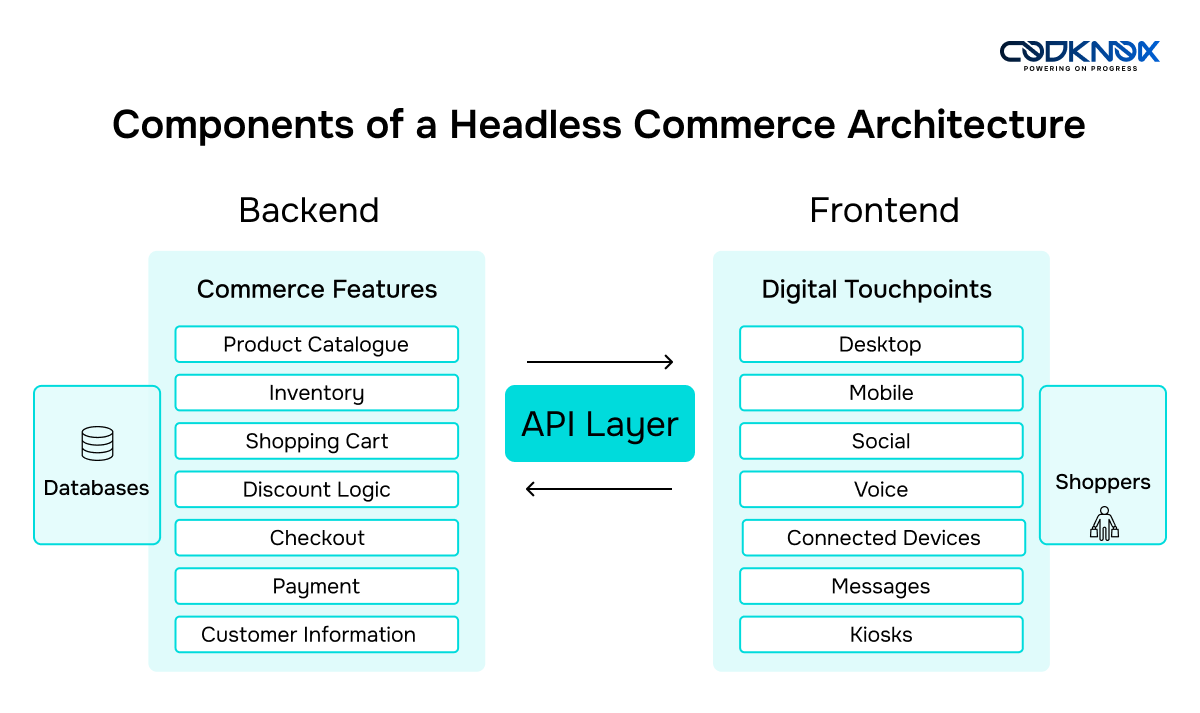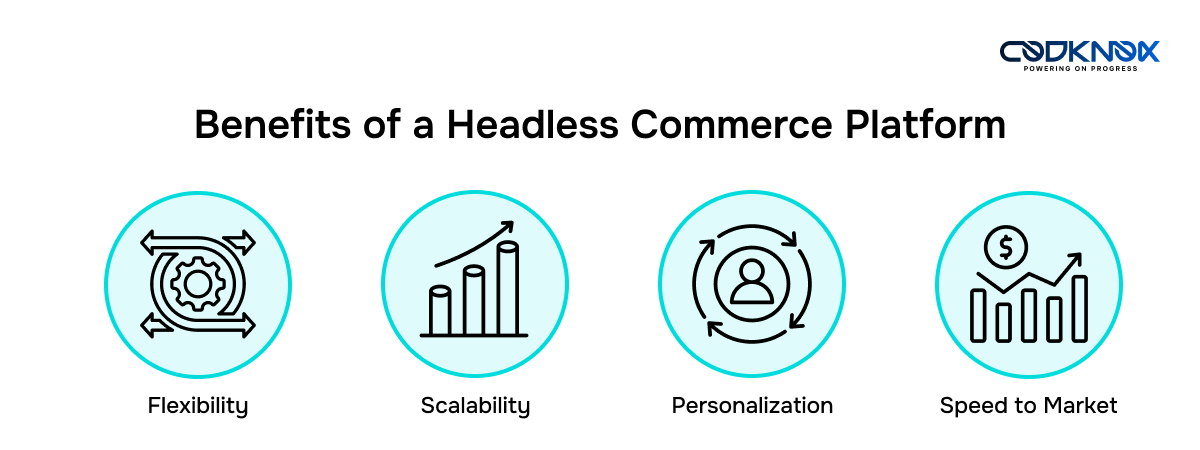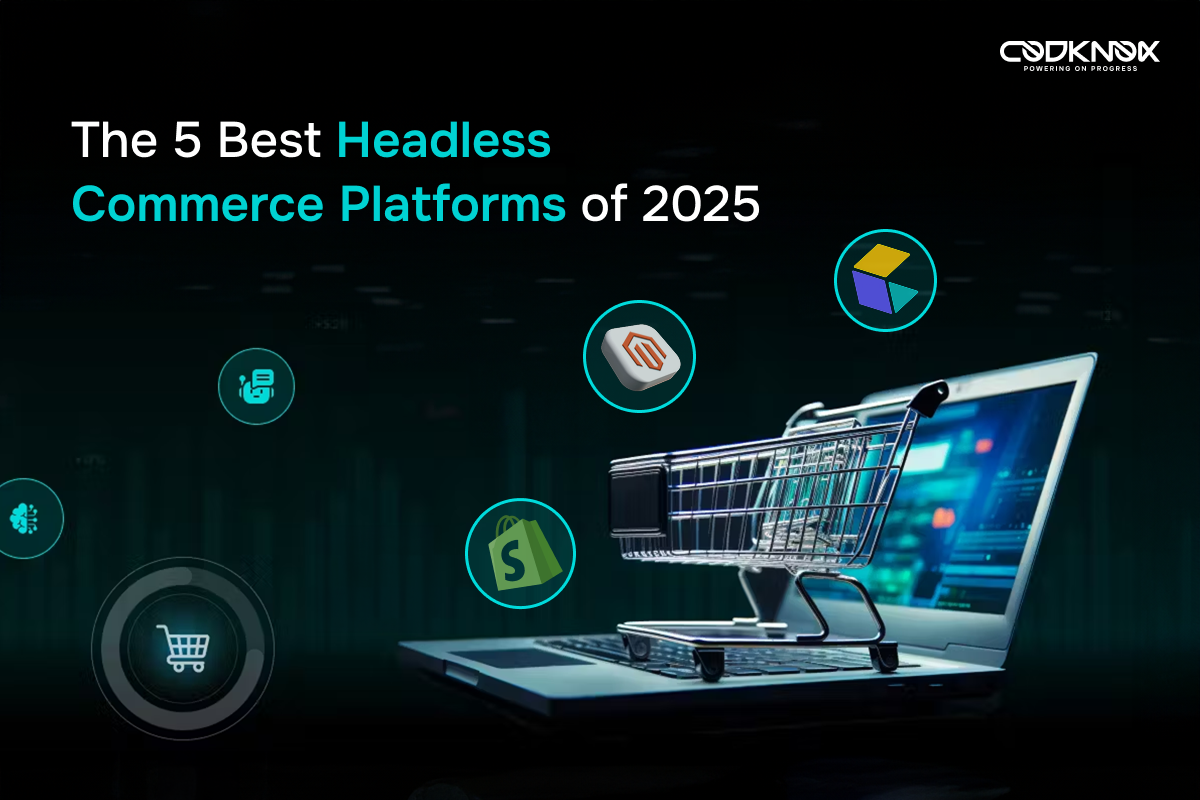Nearly two-thirds of B2C and B2B firms switch to headless commerce to boost agility, scalability, and innovation. A headless commerce platform offers customization options and has a rapidly growing demand. There are numerous headless commerce systems available today, making it more difficult than ever to select which is best for you. Our experts, who have the latest insights into the e-commerce industry and have worked with merchants closely, have come up with the 5 Best Headless Commerce Platforms of 2025. Read on to discover.
What is a Headless Commerce Platform?
A headless commerce in its simplest form is an e-commerce solution where the frontend (what users see) is separated from the backend (where product data, inventories, discount calculations, etc, are managed).
Both platforms have been “decoupled”, meaning if you make a change to one end, it’ll not affect the other end. For the e-commerce industry, that’s a big game-changer. This architecture acts as a blessing for online businesses; with the use of such a platform, brands get the freedom of expression to build whatever and however they desire. And more importantly, it enables businesses to enrich the customer experience.
Headless commerce benefits from API-first architecture, experience managers, and potent tools like Mulesoft and Hereko. These resources are significant as they act as a crucial part of an organization’s strategy, offering new functionality and experiences that attract consumers and meet evolving expectations by staying ahead of trends.
To explain the architecture of a headless commerce platform better, we have created an interactive image. Kindly see the following;

Why Choose a Headless Commerce Platform?
One of the biggest advantages of a headless commerce is that it’s flexible and adapts easily to changing commerce and new technologies. The following are the top three key headless commerce benefits;
Top 3 Benefits of Headless Commerce
1. You Get Complete Creative Control
When you choose a headless commerce, you choose the freedom to utilize creativity wherever required. You can make changes as per your brand vision and limitations. When your business grows, it needs immediate customization to achieve more dynamic and personalized experiences. Usage of advanced themes comes in handy in such scenarios.
Headless commerce offers the best tools to accomplish any kind of bespoke experiences you want to deliver, including limited complexity levels. With commerce, you do not have to make unnecessary cuts in your design expectations.
2. Improved Website Performance
When a buyer visits your website, you have merely seconds to capture their interest. According to Website Builder Expert, 64% of smartphone users anticipate pages to load in less than four seconds, and 40% will not wait longer than three. Slow speeds influence 82 percent of purchasing decisions.
Headless design allows for faster page load times across devices, which can have a direct impact on revenue. A one-second improvement can add $7,000 to a site’s daily revenue of $100,000. On the other hand, sluggish websites lose customers quickly. Headless configurations improve performance, enhance the customer experience, and reduce bounce rates caused by irritating load times.
3. Easy Integration
Existing systems developed in various languages can prohibit important integrations, including those that have adverse effects on the customer experience. But headless commerce gets along with everyone.
With extensive APIs, headless allows you to link all of your existing systems (ERP, PIM, IMS, etc.) and create a shopping experience in your preferred programming language. Not only does it safeguard you from technological changes, but it also allows you to move at your own pace and adapt as quickly as possible.

The 5 Best Headless Commerce Platforms 2025
1. Shopify Plus
Shopify Plus headless commerce has over 48,426 business consumers. It is one of the most used and favored e-commerce platforms globally. It provides a fully hosted commerce backend with a polished admin interface and permits developers to create custom frontends using any technology using Shopify’s APIs.
However, if your e-commerce business is growing and has a small inventory, there’s no reason to upgrade from standard Shopify. The Shopify Plus B2B and API services are primarily advantageous for larger corporate stores, and low payment processing fees will only save you money if you have a high volume of transactions.
Key Features:
- Customizable checkout with access to checkout.liquid
- Shopify Flow for advanced automation
- Dedicated Launch Engineer for onboarding
- Multi-store management from one admin
- Higher Shopify Storefront API limits for seamless integrations
- Script Editor for custom discounts and shipping rules
- 24/7 priority support with a dedicated account manager
Cost:
Shopify provides monthly options starting at $29, $79, and $299. These basic designs provide limited support for becoming headless. However, for businesses that demand more advanced capabilities and earn more than $1 million in annual revenue, Shopify Plus is available for $2,000 each month.
2. BigCommerce
BigCommerce makes enterprise commerce management simpler; it comes with advanced capacities and smart AI innovations. If you want a platform that makes managing multiple brands and storefronts easier for you, choose BigCommerce headless commerce.
Key Features:
- Open API architecture for headless integrations
- BigCommerce multi-channel commerce management from one backend
- Native B2B capabilities
- Seamless integrations with WordPress, Next.js, and more
- Flexible product catalog with custom rules
- Built-in SEO and marketing tools
- 24/7 support and enterprise-level SLAs
Cost:
BigCommerce has no transaction fees, but holds a limit on each plan. The standard plan starts at $29/month. If you exceed $50,000 limit, you’ll be upgraded to the Plus Plan, which will cost you $79. And if you make profits beyond $180,000, you’ll be upgraded to the Pro Plan starting at $299.
3. Adobe Commerce (Magento)
Adobe Commerce is a major enterprise solution that provides rapid, personalized commerce experiences on a platform that can be deployed as a traditional or headless and modular solution. The platform provides both a free open-source version and a considerably more sophisticated and scalable hosted solution for high-growth businesses.
Key Features:
- Flexible and fully customizable open-source platform
- Advanced B2B features (custom pricing, quotes, etc.)
- Page Builder for drag-and-drop content updates
- Robust API support for headless commerce
- Scalable architecture for large product catalogs
- Built-in AI for product recommendations
- Extensive third-party extension marketplace
Cost:
The pricing is not listed on the website. However, there are two plans available- Commerce Pro (suitable for SMEs) and Managed Service.
4. commercetools
Commercetools MACH architecture is one of a kind. It is one of the first headless commerce solutions based on the MACH. The platform provides a variety of modular commerce services, such as catalogs, carts, and orders. These are fully accessible via APIs, giving developers control over creating individualized consumer experiences.
Key Features:
- API-first and microservices-based architecture
- Highly flexible for composable commerce setups
- Supports custom frontends across all devices
- Scalable infrastructure for enterprise growth
- Rich product information management (PIM)
- Internationalization and localization capabilities
- Strong developer tools and documentation
Cost:
The pricing for this platform depends on the demand requirements, estimated at around $45,000 on average.
5. VTEX Commerce Platform
VTEX headless commerce is a composable tool (B2B and B2C) and marketplace platform built on MACH architecture, with comprehensive “apps” to take headless to new heights. The platform innovations have attracted worldwide businesses such as Coca-Cola and Walmart.
Key Features:
- Native, headless, and composable commerce architecture
- Unified B2B and B2C in a single platform
- Built-in marketplace capabilities
- Fast time-to-market with low-code development
- Native OMS (Order Management System)
- Pre-integrated apps and services
- Multi-language and multi-currency support
Cost:
VTEX provides no information on its pricing.
How to Choose a Headless Commerce Platform?
The following are some of the tips to choose the right headless commerce platform for your business:
1. Analyze your business needs
Before you choose a headless commerce, assess your business’s current challenges, objectives, growth goals, and whether you need a solution for B2B, B2C, or both.
2. API Capabilities
Pick a platform with strong and well-documented APIs to enjoy seamless integration and customization.
3. Scalability & Flexibility
See if the platform can handle your ongoing traffic, product range, and future expansion plans.
4. Total Cost
Take the total cost as well, such as licensing, platform plans, maintenance, etc.
Final Thoughts: Choosing the Right Headless Commerce Platform
Switching from traditional to headless commerce in today’s competitive landscape has become necessary. Although for small businesses, the shift may not be fruitful. But for large e-commerce platforms that make countless products and profit, a headless commerce can be extremely beneficial. AI-powered ecommerce platforms can boost their efficiency further with this integration.
However, the trend is making waves in the market; it’s better to join the wave rather than face low profit. If you wish to integrate any of the best headless commerce platforms in 2025, we can help you. Our skilled e-commerce developers hold the expertise to integrate headless commerce seamlessly. For more information or to get started with the switch, get in touch with us. You can schedule a free 15-minute consultation or just drop your project requirements, and we’ll revert within 24 hours.
Frequently Asked Questions (FAQs)
Q1. Is headless commerce suitable for small businesses?
Headless commerce is best suited for medium to large enterprises. Small businesses with fewer requirements may not benefit from the added cost and complexity.
Q2. What is the difference between traditional and headless commerce?
Traditional commerce ties the frontend and backend together. On the other hand, headless commerce does the exact opposite. It separates the two; changes on the frontend and backend can be done separately.
Q3. How much does it cost to implement headless commerce?
The cost depends on numerous factors such as the platform you choose, the plan you choose, business size, and development needs.
Q4. Can I migrate from my current e-commerce platform to headless commerce?
Yes, you can effortlessly migrate to headless commerce with CodKnox. We can help you shift from a traditional platform to headless commerce. For more information, contact our experts.


